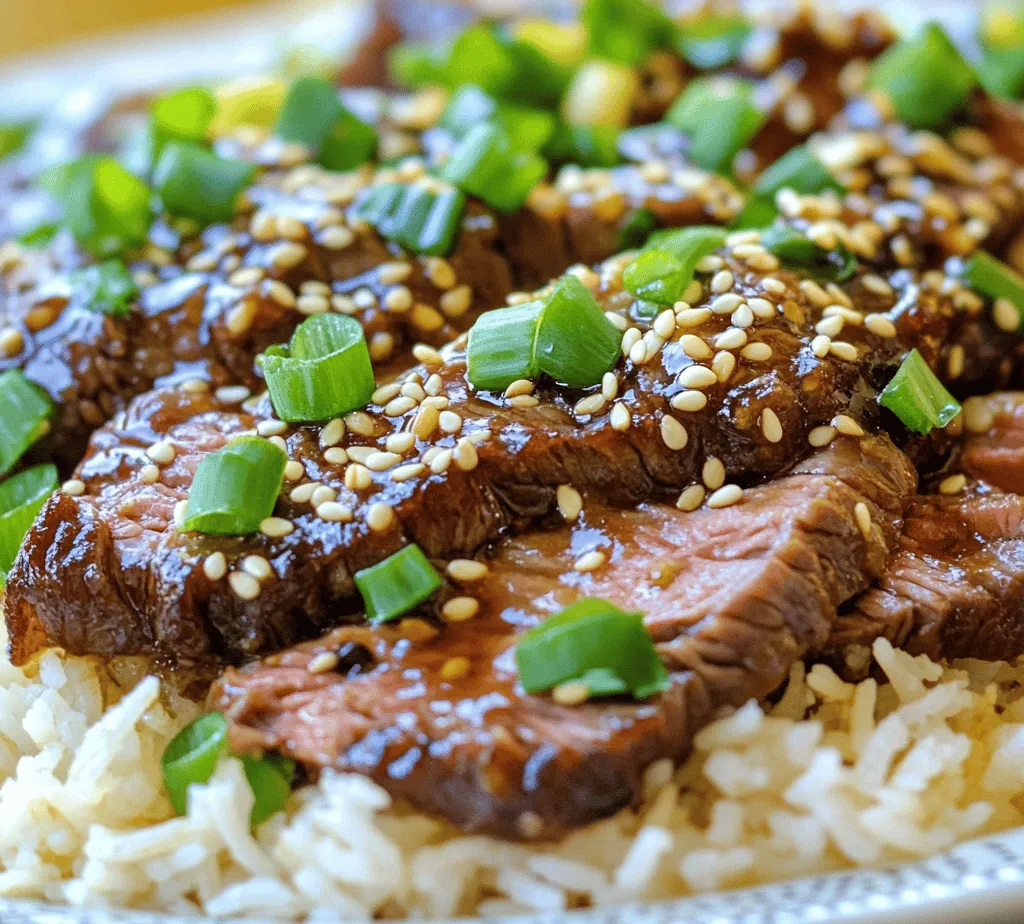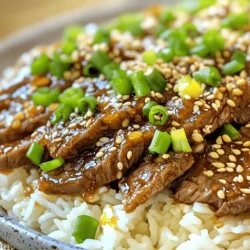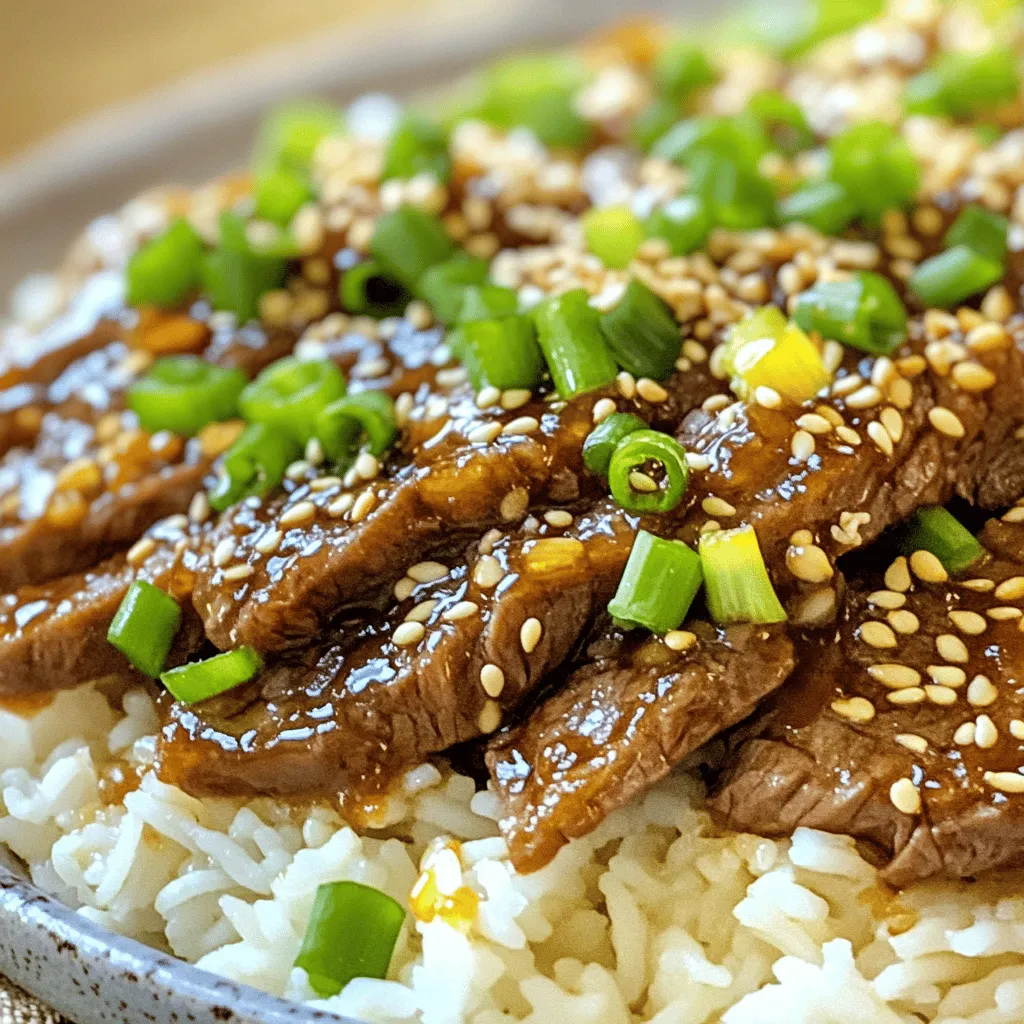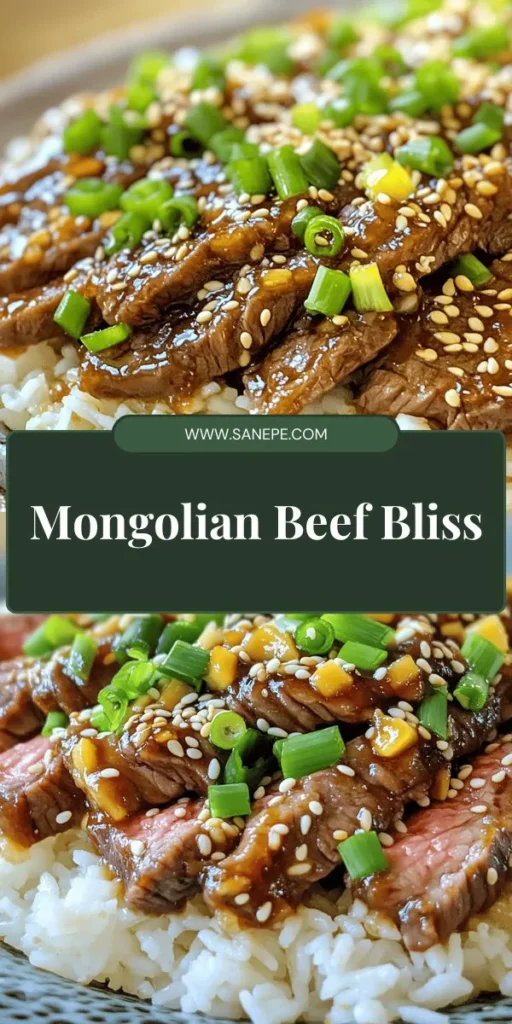Introduction
Mongolian Beef Delight is a savory and satisfying dish that perfectly balances flavors and textures, making it a favorite among many food enthusiasts. Drawing inspiration from classic Asian cuisine, this popular recipe features tender flank steak coated in a sweet and savory sauce, complemented by the freshness of green onions and the aromatic hints of ginger and garlic. This delightful dish not only tantalizes the taste buds but also offers a satisfying culinary experience that can be recreated in the comfort of your own kitchen.
In this article, we will delve into the intriguing origins of Mongolian Beef, examine its key ingredients, and provide a step-by-step guide to creating this delectable dish. Whether you’re a seasoned home cook or a novice looking to expand your culinary repertoire, Mongolian Beef Delight is sure to impress your family and friends.
Understanding the Origins of Mongolian Beef
Exploring the Cultural Roots of Mongolian Beef
Mongolian Beef has become a staple in Chinese-American cuisine, yet its origins are often misunderstood. Contrary to what the name suggests, Mongolian Beef is not an authentic dish from Mongolia. Instead, it has been popularized in North America, especially in Chinese restaurants. The dish is believed to have been influenced by the culinary practices of various Asian cultures, including Chinese, with a focus on flavors that appeal to Western palates.
Historically, the dish is thought to have emerged in the late 20th century. It gained popularity as Chinese-American cuisine began to flourish, with dishes often adapted to suit local tastes. The combination of sweet and savory flavors, along with the tender texture of the beef, made Mongolian Beef a hit among diners seeking something different yet familiar. Over the years, it has evolved and taken on various interpretations, but the core elements remain consistent.
Common Misconceptions About the Dish’s Authentic Origins
It’s essential to clarify that Mongolian Beef is not a traditional dish from Mongolia. Many people mistakenly associate the name with Mongolian cuisine due to the use of flank steak and the cooking techniques employed. In reality, authentic Mongolian dishes often feature lamb, mutton, and dairy products, reflecting the nomadic lifestyle of the Mongolian people.
The name “Mongolian Beef” was likely chosen to evoke a sense of exoticism and intrigue, making it more appealing to American diners. Regardless of its origins, the dish has carved out a significant place in the hearts of food lovers and continues to be a beloved choice for those seeking a flavorful and satisfying meal.
Key Ingredients and Their Roles
Creating the perfect Mongolian Beef Delight requires a thoughtful selection of ingredients, each playing a crucial role in developing the dish’s signature flavor profile. Below, we break down the essential components that make this recipe shine.
Flank Steak: Best Cuts for Mongolian Beef and Tips for Slicing
Flank steak is the star of Mongolian Beef, providing a rich, beefy flavor that pairs beautifully with the sauce. When choosing flank steak, look for cuts that are bright red with minimal visible fat. Tender and lean, flank steak benefits from marinating and quick cooking methods, making it ideal for this dish.
To achieve the best results, slicing the flank steak correctly is essential. Always cut against the grain to ensure tenderness. Thin slices (about 1/4 inch thick) allow the meat to absorb the flavors of the marinade and sauce effectively. For added flavor, consider marinating the steak for at least 30 minutes before cooking.
Soy Sauce: Varieties and Flavor Profiles
Soy sauce is a fundamental ingredient in Mongolian Beef, contributing saltiness and depth of flavor. There are various types of soy sauce, including light, dark, and tamari. For this recipe, using a combination of light soy sauce and dark soy sauce can enhance the dish’s complexity. Light soy sauce adds saltiness, while dark soy sauce imparts sweetness and color.
When selecting soy sauce, opt for high-quality brands that use traditional brewing methods for the most authentic flavor. Low-sodium soy sauce is also available for those looking to reduce their sodium intake without sacrificing flavor.
Cornstarch: Importance in Achieving the Crispy Texture
Cornstarch plays a critical role in achieving the desired crispy texture of the beef in Mongolian Beef Delight. When coated on the flank steak before cooking, cornstarch creates a light crust that crisps up during frying, sealing in the juices and flavors. This technique not only enhances the texture but also contributes to the overall presentation of the dish.
To coat the steak, simply toss the sliced meat with cornstarch in a bowl until evenly coated. This step is crucial for achieving that signature crunch that makes Mongolian Beef so enjoyable.
Vegetable Oil: Best Choices for High-Heat Cooking
When it comes to cooking Mongolian Beef, choosing the right oil is essential. Vegetable oil is the preferred choice due to its high smoke point, making it suitable for stir-frying at high temperatures. Other great options include canola oil and peanut oil, both of which can withstand high heat without burning.
For the best results, heat the oil until it shimmers before adding the beef. This ensures that the meat cooks quickly, allowing for a tender and juicy end product.
Fresh Ginger and Garlic: Enhancing Flavor and Health Benefits
Fresh ginger and garlic are integral to the flavor profile of Mongolian Beef. Ginger adds warmth and a hint of spiciness, while garlic contributes a savory depth. Together, they create a fragrant base that elevates the dish.
In addition to their flavor contributions, both ginger and garlic come with health benefits. Ginger is known for its anti-inflammatory properties and digestive benefits, while garlic is praised for its immune-boosting capabilities. Incorporating these ingredients not only enhances the taste but also adds a nutritional boost to your meal.
Brown Sugar: Balancing Sweetness with Savory Elements
Brown sugar is a key ingredient that balances the savory flavors in Mongolian Beef Delight. It adds a subtle sweetness that complements the soy sauce and enhances the overall flavor profile. The caramelization of the sugar during cooking also contributes to a rich, glossy sauce that clings to the beef.
When selecting brown sugar, you can use either light or dark varieties. Light brown sugar has a milder flavor, while dark brown sugar provides a more intense molasses taste. For a balanced flavor, feel free to experiment with both types.
Green Onions: Adding Freshness and Color
Green onions, or scallions, are used as both an ingredient and a garnish in Mongolian Beef. Their mild onion flavor and bright green color add freshness to the dish, creating a visually appealing presentation. Slicing them thinly and adding them to the stir-fry not only enhances the taste but also provides a pop of color that contrasts beautifully with the rich sauce.
For the best results, use the white and light green parts of the green onions in the cooking process, and reserve the dark green tops for garnishing just before serving.
Sesame Oil: Final Touch for Depth of Flavor
A drizzle of sesame oil at the end of cooking adds a nutty aroma and depth of flavor to Mongolian Beef Delight. This oil is rich and concentrated, so a little goes a long way. Use toasted sesame oil for a deeper flavor, and add it just before serving to retain its aromatic qualities.
Sesame oil is also known for its health benefits, including antioxidants and anti-inflammatory properties. Its inclusion in the dish not only enhances the flavor but also contributes to a balanced meal.
Optional Ingredients: Red Pepper Flakes for Heat and Sesame Seeds for Garnish
For those who enjoy a bit of heat, consider adding red pepper flakes to the dish. A pinch can elevate the flavor profile and provide a spicy kick that complements the sweetness of the sauce. Adjust the amount according to your heat preference, and feel free to experiment with fresh chili peppers for a more intense flavor.
Additionally, sesame seeds make for an excellent garnish, adding a delightful crunch and a nutty flavor that enhances the overall dish. Toasting the sesame seeds before sprinkling them on top can amplify their flavor, making your Mongolian Beef Delight even more enticing.
Prepping Your Ingredients
To ensure a smooth cooking experience, it’s essential to prep your ingredients efficiently. Here’s a step-by-step guide to help you get everything ready for making Mongolian Beef Delight.
Marinating the Flank Steak: Importance of Seasoning and Timing
Marinating the flank steak is a crucial step that enhances the flavor and tenderness of the meat. To prepare the marinade, combine soy sauce, brown sugar, minced ginger, and minced garlic in a bowl. Whisk the ingredients together until the sugar dissolves completely.
Place the sliced flank steak in a resealable plastic bag or a shallow dish, and pour the marinade over the meat. Ensure that all pieces are evenly coated. Seal the bag or cover the dish with plastic wrap and refrigerate for at least 30 minutes, or up to 2 hours for more intense flavor absorption. This marinating process not only infuses the beef with flavor but also helps to tenderize it, resulting in a more enjoyable eating experience.
Once the marinating time is up, remove the steak from the refrigerator and let it sit at room temperature for about 10-15 minutes before cooking. This allows the meat to cook more evenly.
By taking the time to properly prep your ingredients and marinate the flank steak, you’re setting the stage for a delicious Mongolian Beef Delight that will impress everyone at the dinner table. Stay tuned for the next part of this article, where we will explore the step-by-step cooking instructions to bring this delightful dish to life.

Coating with Cornstarch: Technique for Achieving the Desired Texture
One of the secrets to achieving that signature crispy texture in Mongolian Beef Delight lies in the cornstarch coating. This method not only adds a delightful crunch but also helps to seal in the juices of the beef, resulting in a tender and flavorful dish. To coat the beef with cornstarch effectively, follow these steps:
1. Slice the Beef: Start by slicing your beef against the grain into thin strips, about 1/4 inch thick. This will ensure tenderness.
2. Seasoning: In a bowl, combine the sliced beef with a pinch of salt and a dash of pepper. You can also add a teaspoon of soy sauce for extra flavor.
3. Cornstarch Coating: Sprinkle a generous amount of cornstarch over the beef. Using your hands, gently toss the beef until each piece is well-coated. Ensure that there is an even layer of cornstarch on each strip; this will help achieve that perfect crispy texture when cooked.
This coating technique is crucial as it creates a light barrier that helps to crisp the beef while it cooks, leading to a more satisfying mouthfeel in your Mongolian Beef Delight.
Chopping Aromatics: Proper Methods for Preparing Ginger, Garlic, and Green Onions
Aromatics play a vital role in elevating the flavors of Mongolian Beef Delight. Properly chopping your ginger, garlic, and green onions ensures that their flavors are released effectively during cooking.
Ginger
1. Peeling: Start by peeling the ginger using the edge of a spoon or a vegetable peeler.
2. Slicing: Cut the ginger into thin slices, then stack a few slices and cut them into matchsticks.
3. Mincing: Finally, gather the matchsticks and finely mince them into small pieces. This will help release the aromatic oils and enhance the overall flavor profile of your dish.
Garlic
1. Peeling: Remove the outer skin of the garlic bulb and separate the cloves.
2. Crushing: Use the flat side of a chef’s knife to crush each clove slightly. This helps to release the juices.
3. Mincing: Finely chop the crushed garlic cloves to ensure even distribution in your dish.
Green Onions
1. Trimming: Cut off the root ends and any wilted green tops.
2. Slicing: Slice the green onions thinly, using both the white and green parts. The white part adds a sharp flavor, while the green part provides a fresh finish.
With your aromatics prepped, you are ready to infuse your Mongolian Beef Delight with their vibrant flavors.
Cooking Instructions
Now let’s dive into the comprehensive guide to cooking Mongolian Beef Delight. This section will ensure that you achieve the perfect balance of flavors and textures in your dish.
Heating the Skillet: Tips for Achieving the Ideal Cooking Temperature
Begin by selecting a large skillet or wok, as this will allow you enough space to cook the beef without overcrowding. Heat the skillet over medium-high heat until it is hot but not smoking. A properly heated skillet is crucial because it will help to sear the beef quickly, locking in juices and preventing it from becoming tough.
To test if the skillet is ready, you can splash a few drops of water into the pan. If they sizzle and evaporate almost immediately, your skillet is at the right temperature.
Browning the Beef: Importance of Cooking in Batches for Even Searing
Once the skillet is heated, add a tablespoon of cooking oil (such as vegetable or canola oil) and swirl it around to coat the bottom of the pan. It’s essential to avoid overcrowding the skillet, as this can cause the beef to steam instead of sear.
Cook the beef in batches, adding just enough to cover the bottom of the skillet without overcrowding. Allow each side to brown for about 1-2 minutes without stirring. This will create a nice crust on the beef. Once browned, remove the beef from the skillet and set it aside on a plate. Repeat this process until all the beef is cooked.
Making the Sauce: Balancing Flavors for a Rich and Glossy Finish
With the beef cooked and resting, it’s time to make the sauce. In the same skillet, reduce the heat to medium and add a little more oil if necessary. Add the minced ginger and garlic, stirring for about 30 seconds until fragrant. Be careful not to burn them, as this can impart a bitter flavor to the dish.
Next, pour in the soy sauce, brown sugar, and a splash of water. Stir to dissolve the sugar and combine the ingredients. Let the sauce simmer for a couple of minutes to thicken slightly. You can also add a tablespoon of hoisin sauce or oyster sauce at this stage for an additional depth of flavor.
Combining the Ingredients: Ensuring Even Coating and Flavor Distribution
Once the sauce has reached the desired consistency, return the cooked beef to the skillet. Toss the beef in the sauce, ensuring that every piece is well-coated. This step is crucial for flavor distribution, as the sauce clings to the cornstarch coating, creating a glossy finish.
Add the sliced green onions, reserving a few for garnishing. Stir everything together for another minute to allow the flavors to meld. The heat should be medium-low at this stage to avoid overcooking the beef.
Serving Suggestions
Mongolian Beef Delight is not just about taste; it’s also about presentation. Here are some creative ideas for serving this delectable dish:
Ideal Accompaniments
For a well-rounded meal, consider serving Mongolian Beef Delight over a bed of fluffy jasmine rice. The rice soaks up the delicious sauce, making every bite a delight. Alternatively, you can serve it with noodles, such as lo mein or rice noodles, which also pair beautifully with the rich flavors of the beef.
For a healthier option, consider stir-fried vegetables like bell peppers, broccoli, and snap peas. The vibrant colors and crunch of the vegetables will complement the dish while adding nutritional value.
Garnishing Options
To enhance the visual appeal of your dish, garnish it with a sprinkle of toasted sesame seeds and the reserved green onions. This not only adds flavor but also gives a beautiful contrast to the deep brown color of the beef.
Portioning for Family-Style Dining vs. Individual Servings
For a family-style dining experience, serve the Mongolian Beef Delight directly from the skillet onto a large platter, allowing everyone to help themselves. This creates a communal atmosphere that encourages sharing and enjoyment.
If you prefer individual servings, plate the beef over rice or noodles in shallow bowls for an elegant presentation. Add a garnish of green onions and sesame seeds on top for an appealing finish.
Nutritional Information
Understanding the nutritional aspects of Mongolian Beef Delight can help you make informed choices while enjoying this scrumptious dish.
Caloric Content and Macronutrient Breakdown per Serving
A typical serving of Mongolian Beef Delight (approximately one cup) contains around 300-400 calories, depending on the specific ingredients and cooking methods used. The macronutrient breakdown is generally as follows:
– Protein: 30-35 grams (primarily from beef)
– Fat: 10-15 grams (mostly from cooking oil and the natural fat in beef)
– Carbohydrates: 25-30 grams (from sauce and any side dishes)
Health Benefits of Key Ingredients
Mongolian Beef Delight features several key ingredients that offer health benefits:
– Beef: A rich source of high-quality protein, iron, and B vitamins, which support muscle health, energy production, and overall well-being.
– Ginger and Garlic: Both are known for their anti-inflammatory and immune-boosting properties. They can also aid in digestion.
– Green Onions: Provide vitamins A, C, and K, along with antioxidants, promoting overall health.
Dietary Considerations: Gluten-Free and Low-Carb Adaptations
For those with dietary restrictions, Mongolian Beef Delight can be easily adapted. To make it gluten-free, simply use tamari instead of soy sauce. For a low-carb version, consider serving the beef atop a bed of steamed cauliflower rice instead of traditional rice or noodles.
Conclusion
Mongolian Beef Delight is more than just a meal; it’s a culinary experience that brings together bold flavors and satisfying textures. With its simple preparation and delicious results, this dish is perfect for family dinners or entertaining guests. By understanding the origins, key ingredients, and cooking techniques, you can confidently recreate this delightful recipe in your kitchen, bringing a taste of Asian-inspired cuisine to your dining table. Enjoy the journey of cooking and savor every bite of this delicious dish.
With each step meticulously outlined, you’re now equipped to create a restaurant-quality Mongolian Beef Delight in your home. Don’t hesitate to experiment with the flavors and make this dish your own. Happy cooking!


